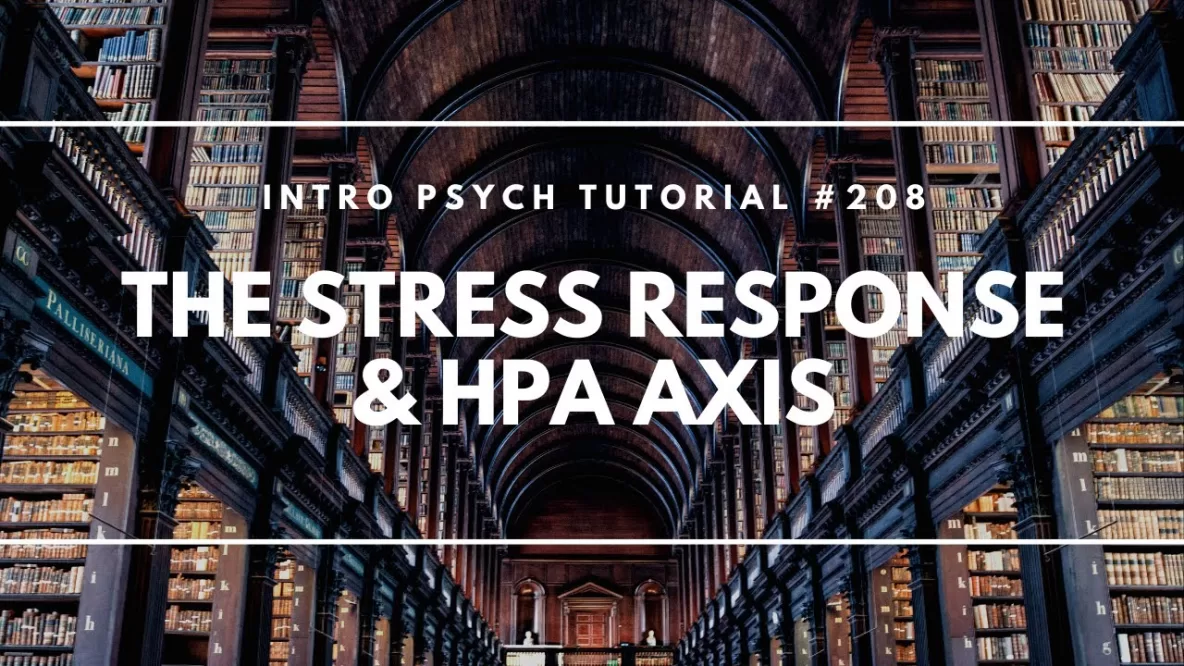In this video I describe the stress response in more detail, including possible gender differences in reaction to threats. Shelley Taylor proposed the tend–and–befriend response to refer to a female tendency to focus on relationships, empathy, and group cohesion in response to threats. Next I describe how the stress response travels through the body, which occurs along the HPA axis (Hypothalamus, Pituitary, Adrenal glands) and includes release of corticotropin releasing hormone (CRH), adrenocorticotropic hormone (ACTH), the catecholamines epinephrine & norepinephrine (adrenaline & noradrenaline), and glucocorticoids including cortisol. The stress response mobilizes energy to prepare for a threat, but in doing so it reduces activities related to long-term projects like digestion, reproduction, and immune function.
Don’t forget to subscribe to the channel to see future videos! Have questions or topics you’d like to see covered in a future video? Let me know by commenting or sending me an email!
Check out my full psychology guide: Master Introductory Psychology: http://amzn.to/2eTqm5s
Video Transcript
Hi, I’m Michael Corayer and this is Psych Exam Review. In the previous video I talked about different types of stressors that evoke a stress response, so in this video I’d like to look at this stress response in more detail. Now I’ve talked about the idea of the fight–or–flight response, as well as the addition of a freeze response, and these refer to how organisms react to threats or predators.
They have a tendency to fight to flee or to freeze, but it’s also been proposed that there might be gender differences in reaction to threats. Shelley Taylor has suggested that females are less likely to show aggressive behavior in response to threats and they’re more likely to exhibit what she calls a tend–and–befriend response. This refers to a greater focus on relationships, empathy, and group cohesion in response to threats and this may have something to do with greater release of the hormone oxytocin in females compared to males in response to threats. Some research by Mara Mather and colleagues in 2010 found that females showed greater activation of brain areas associated with facial recognition and empathy in response to threats.
So what’s going on in the body during a stress response? Well, most of this action is occurring along the HPA axis and this refers to the hypothalamus, pituitary, and adrenal glands and this is a sort of chain reaction starting in the hypothalamus and ending with the release of hormones by the adrenal glands. So you might remember when I talked about areas of the brain in a previous video I talked about the pituitary gland and in many textbooks it’s referred to as the “master gland” but as I said before, and as we’ll see, the pituitary is not really the master because it’s controlled by hormones released by the hypothalamus.
So the HPA axis begins with the hypothalamus releasing hormone called CRH in response to a threat. This is corticotropin–releasing hormone and this tells the pituitary gland to release its hormone which is ACTH or adrenocorticotropic hormone. And so when the pituitary releases this adrenocorticotropic hormone, this travels in the bloodstream and reaches the adrenal glands, which are located just on top of the kidneys. When the adrenal glands receive this signal from the ACTH, they release two groups of hormones; catecholamines and glucocorticoids.
And here’s a simple diagram showing this HPA axis. So we have the hypothalamus here releasing its CRH, which is going to tell the pituitary gland to release ACTH, which is then going to travel in the bloodstream and get to the adrenal glands here just above the kidneys. And they’re going to release catecholamines and glucocorticoids.
Ok, so what are catecholamines and glucocorticoids? So the main catecholamines that are released are epinephrine and norepinephrine; but you probably know them better by their British names adrenaline and noradrenaline. And it’s much easier to remember that adrenaline and noradrenaline are released by the adrenal glands. The glucocorticoids are steroid hormones and what these do is they mobilize energy by increasing glucose in the bloodstream and they also temporarily reduce inflammation. You might be familiar with one glucocorticoid and this is cortisol.
And you might be familiar with this as this stress hormone, but you might also be familiar with its pharmaceutical name hydrocortisone and you might be familiar with this being used in lotions and creams that you can put on your skin to reduce inflammation in response to things like mosquito bites or rashes. But you might also know that you have to be careful with the use of hydrocortisone because you shouldn’t put it on your skin too frequently. If you do it can actually cause long-term skin damage, and that’s a good way of thinking about the effects of glucocorticoids. They are effective in small doses and on a temporary basis, but you don’t want them around all the time and one of the reasons for this is that the stress response emphasizes immediate needs everything else is secondary. It’s all about escaping from the current threat and so this means that anything that’s a long-term project is going to be reduced during the stress response.
So things like digestion and hunger drive are reduced; you won’t stop for a snack while you’re sprinting from a tiger. And similarly, reproductive functions and sex drive are reduced during periods of high stress and stress response. And lastly, and most importantly for several of the future videos, the processes of the immune system are impaired by the stress response. The immune function is temporarily reduced during the stress response and we’ll see the potential long-term effects of that in future videos. I hope you found this helpful, if so, please like the video and subscribe to the channel for more. Thanks for watching!

